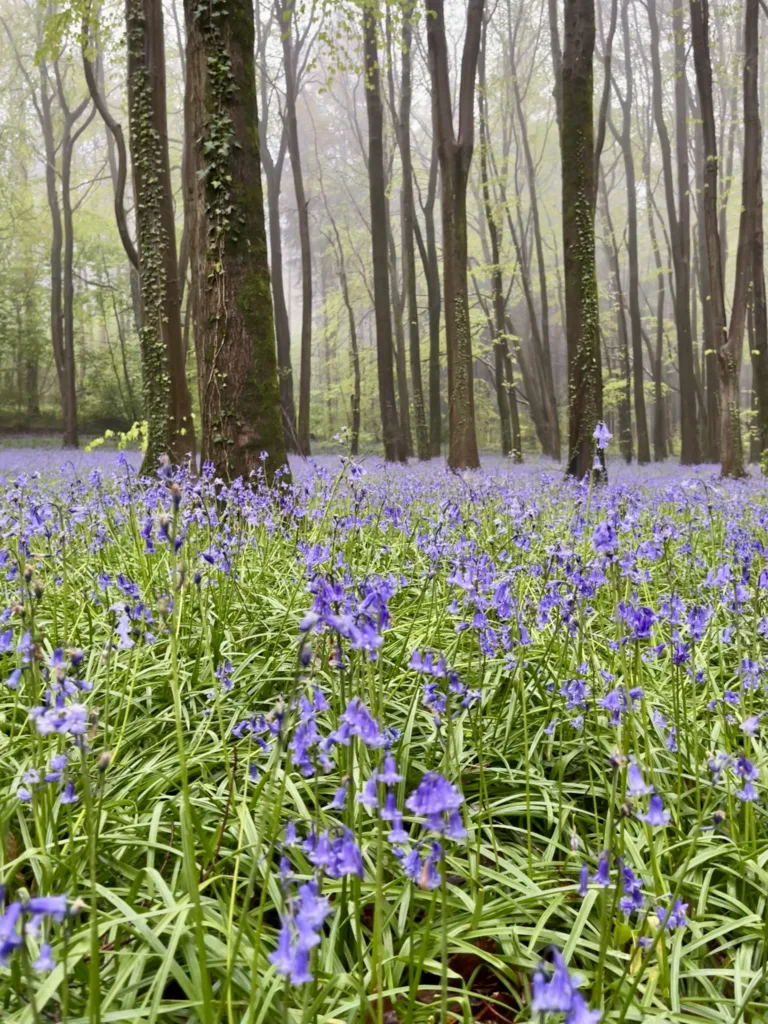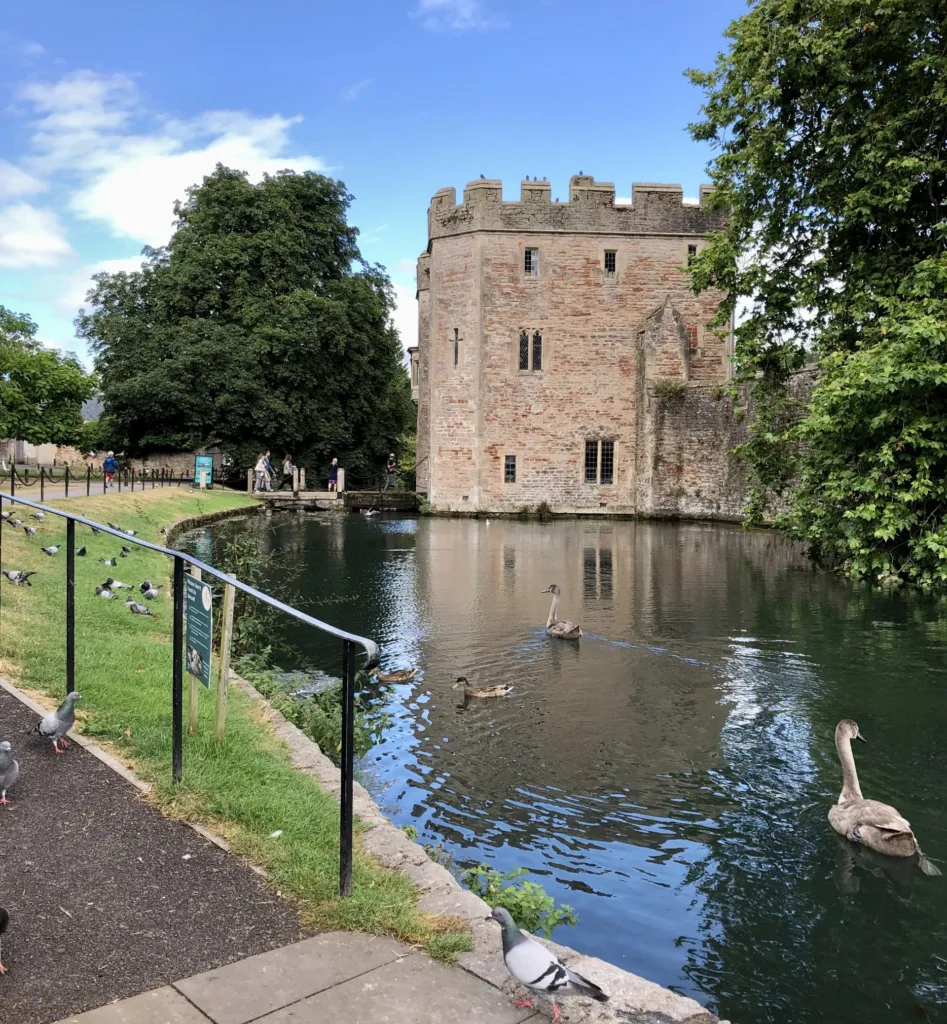Table of Contents - Tap to jump to a section
ToggleThe Best Bluebell Woods in Somerset
Spring is one of the best times to go out for a walk. Every year bluebells transform woodland floors and hedgerows across Britain. There is always something special about a walk in the woods when the woodland floor is awash with a carpet of blue flowers. It’s a magical sight and one of our favourite outdoor activities in the spring – the vibrant colour, gorgeous fragrance, delicate blooms, and the realisation that summer is just around the corner.
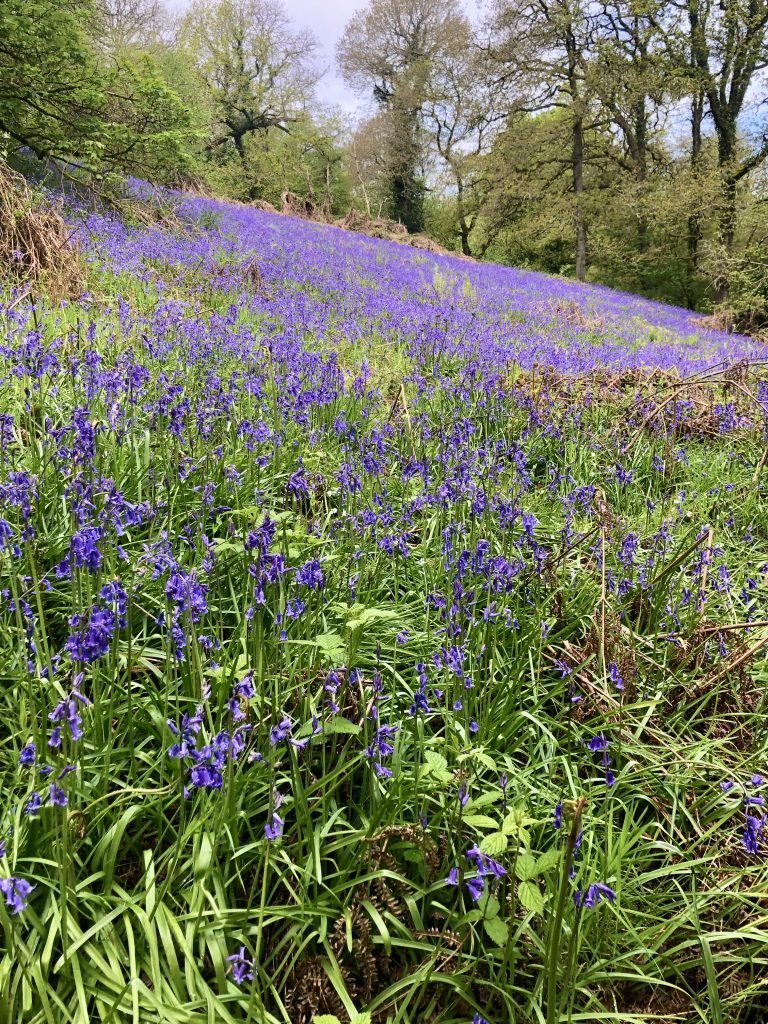
Where to see Bluebells
Bluebells are native to Western Europe and in particular, the UK. About half of the world’s population of bluebells can be found in the UK which is great news for us! Bluebells grow predominantly in ancient, broadleaf woodlands, but newer colonies can also be found in smaller numbers along hedgerows and in fields.
Many thousands of bulbs can grow which is a good indication that a wood is ancient. Ancient woods are classed as areas of woodland that have persisted since 1600 in England, Wales, and N. Ireland, and 1750 in Scotland.
When do Bluebells flower in the UK?
Native Bluebells flower in late Spring in the UK, during the months of April and May. The flowers reach their peak in May, but it depends where you are in Britain. Generally, the colder the region and weather, the later the bluebells flower. The blooms only last for a few weeks so making the most of the bluebell season is crucial.
Do Bluebells flower every year?
Bluebells are perennials which means they flower every year. Bluebell colonies take between 5-7 years to develop from seed to flower and can take years to recover from the damage caused by trampling. Bluebells are sensitive plants, and it is extremely important to avoid trampling bluebells to protect the delicate flowers and prevent their leaves being crushed.
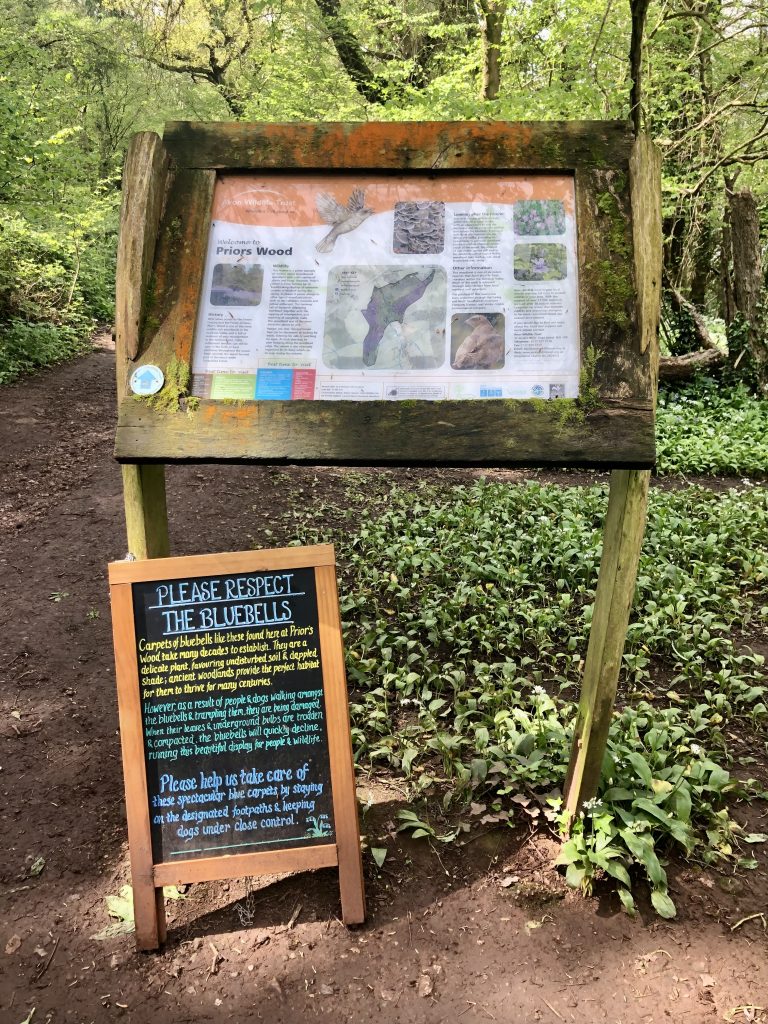
Always keep to the paths when walking because areas of high footfall can even cause entire colonies to die out. As a protected species it is important not to pick bluebells. If bluebell bulbs are damaged it can take several years for them to flower again, sometimes not at all.
Did you know? Bluebells are poisonous. All parts of the plant are toxic because they contain chemicals called Glycosides. Glycosides are toxic for humans, dogs and horses. So, this is another reason not to pick them!
Where can I see Bluebells in Somerset?
The ancient woodlands in Somerset have some of the most beautiful native bluebell displays in Britain. The violet colour of a bluebell wood is a magnificent wildflower spectacle. Make a point of visiting a bluebell wood near you this spring, there are many bluebell hotspots in Somerset.
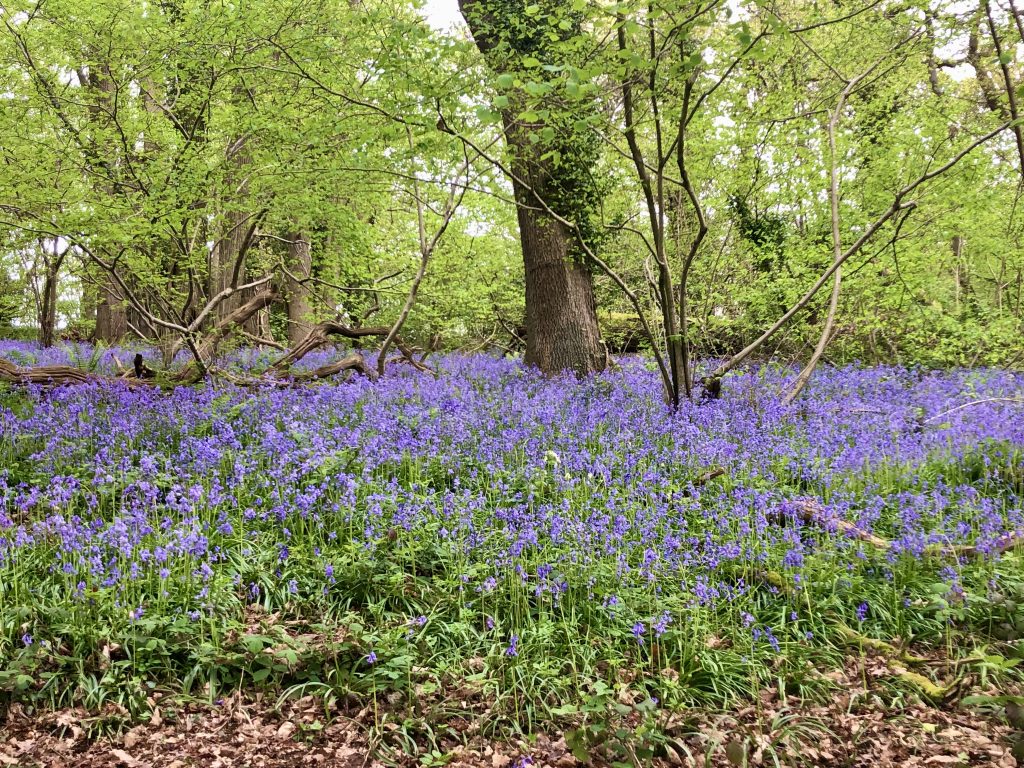
Here is our guide to the Best Bluebell Woods in Somerset
1. Prior’s Wood, Portbury
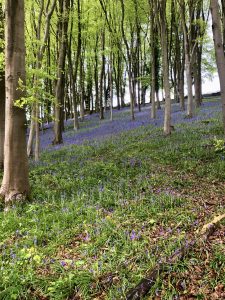
Just a short drive from Bristol in North Somerset is Prior’s Wood. Avon Wildlife Trust manage this stunning ancient woodland, rich in wildlife and it is our favourite place to see the carpet of bluebells in spring. The kids love paddling in the stream which runs through the woods so make sure to wear your wellies! Don’t forget to stop for a yummy homemade cake at the Bluebell Cafe at the church before you go home (open weekends and bank holidays 11am – 5pm.
Pub Stop: The Priory at Portbury
Parking: St Mary’s Church car park, Church Lane, Portbury (sign posted)
2. Long Wood, near Cheddar Gorge (SSSI)
*UPDATE – Long Wood is currently fenced off and closed to the public due to Ash dieback and dangerous trees.*
The ancient woodland of Long Wood is a popular spot for a bluebell walk in late spring. It is managed by the Somerset Wildlife Trust and its oldest nature reserve. There is a 3-mile circular hike which starts at Black Rock and takes in Velvet Bottom Nature Reserve. These two reserves make up Cheddar Complex. There are stunning views over the Mendip Hills and an impressive display of Bluebells, Wild Garlic, and Dog’s Mercury on the woodland floor. Roadside parking on Cliff Road and enter through Black Rock. Download a nature trail from the Somerset Wildlife Trust and try the Hedgehog Award Activities.
Beware, there are some steep steps through the woodland
Pub Stop: The Sheppey Inn at Lower Godney or The Swan in Wedmore
3. Leigh Woods, Abbots Leigh
On the outskirts of Bristol next to the Avon Gorge and iconic Clifton Suspension Bridge, is Leigh Woods. An ancient woodland nature reserve, managed by the National Trust and Forestry England, it has been designated a Site of Special Scientific Interest due to the abundance of rare flora and fauna. There are waymarked trails with well-trodden paths throughout the woods.
Paid car parking, picnic tables and a downloadable family trail here. Keep to the footpaths and beware of the mountain biking trails.
Pub Stop: The White Lion, Clifton for views of Clifton Suspension Bridge.
4. Goblin Combe, Cleeve
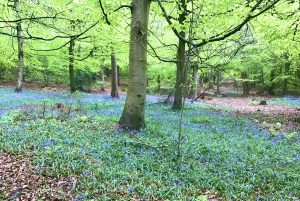
Goblin Combe is a site of Special Scientific Interest managed by Avon Wildlife Trust. Follow one of 3 waymarked trails through the woodland gorge and up to the grasslands above for great views over the Mendips. The woodland floor is covered in bluebells and wild garlic in the spring. Look out for the feral goats grazing the area to create space for a larger diversity of plants and butterflies.
Small car park on Cleeve Hill Road.
Pub Stop: The Plough in Wrington or The Crown at Churchill (our family fave!)
5. Brean Down (NT), near Weston super Mare
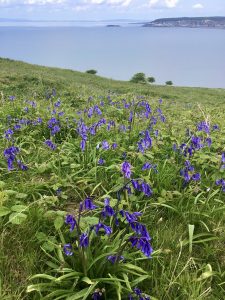
The peninsular of Brean Down is a lovely 3-mile walk, with great views over the Bristol Channel. Every May the north side is carpeted with bluebells. This is a great family walk which has the interesting old Palmerston Fort to explore and huge beach which the kids will love! Brean Down is free to walk around. Pay and display NT car park next to the beach. Beware of cliff edges and lots of steps.
Pub Stop: Brean Down Inn
6. King’s Castle Wood, Wells
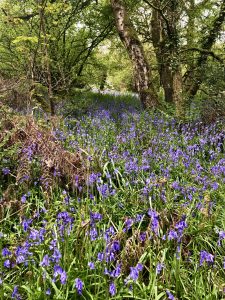
Just outside Wells is King’s Castle Wood, an ancient woodland managed by Somerset Wildlife Trust. The site was where an Iron Age Fort once stood and is now rich in wildflowers, including Bluebells which dominate the ground in spring. You may spot grey squirrels and even Roe Deer. Please note, there is no car park. Access via footpath from Wells.
Pub Stop: The Globe Inn, Wells
7. Thurlbear Wood, Taunton (SSSI)
South-East of Taunton is Thurlbear Wood, an ancient woodland managed by Somerset Wildlife Trust. This nature reserve has a great variety of wildlife and wildflowers, with a sea of Bluebells, alongside Wild Dog Violets and Primroses in April and May. Look out for the great views over the Blackdown Hills.
Parking on roadside near the entrance.
Pub stop: The Farmer’s Arms, West Hatch
8. Ashcombe Wood (and Worlebury Wood), Weston-super-Mare
Ashcombe Wood, part of Weston Wood is situated on Worlebury Hill in Weston-super-Mare, between Sand Bay and Weston Beach. It makes up a Local Nature Reserve where you’ll find the remains of an Iron Age Hillfort at the western tip of Weston Woods. Parts of the defensive walls and storage pits are still visible. There is a great view from here of the old Birnbeck Pier, across the Bristol Channel to Wales. Ashcombe Wood, in the south-eastern section, is classed as ancient semi-natural woodland. Here, the ground is covered with bluebells and wildflowers in the spring.
Kids will love the wooden play area near the start of the walk. Car park is free.
Pub Stop: The Nut Tree, Worle
9. Bishop’s Palace, Wells
The Palace grounds is home to the Arboretum which was created in 1977 in commemoration of the Queen’s Silver Jubilee. The arboretum has been managed for wildlife and wildflowers. In spring the garden is awash with bluebells, primroses, and other wildflowers. Admission prices here, or, the entry is free most Fridays to RHS members.
Pub Stop: The Fountain Inn, Wells
10. Ebbor Gorge, Wells (NT)
Ebbor Gorge National Nature Reserve is a few miles from the city of Wells on the southern ridge of the Mendip Hills (AONB), and is part of the Mendip Woodland Special Area of Conservation. Visit in the springtime to see a carpet of bluebells, wood anemone and dogs mercury on the woodland floor. Look out for the many species of butterfly in this area, as well as rabbits, and in the evening, you may see bats that roost in the caves there. There is a small, free car park at Ebbor Gorge, and three trails to choose from.
Pub Stop: The Burcott Inn, Wells
11. Aller and Beer Woods, Langport
Aller and Beer Woods is a Site of Special Scientific Interest managed by Somerset Wildlife Trust. Here, you can explore this ancient woodland, walk among the bluebells and other wildflowers in spring, and enjoy the outstanding views across Aller Moor on the Somerset Levels.
Parking in Aller Village or limited roadside parking at Turn Hill.
Pub Stop: The Halfway House, Langport
12. Tyntesfield, Wraxall (NT)

Tyntesfield Estate is always a great place for a family walk, particularly in spring. The woodland areas on the Estate, especially Truckle Wood, is a lovely walk to see the impressive display of bluebells.
Paid parking, or free for National Trust members. The kids will love the two wooden play areas in the grounds of Tyntesfield. Admission prices here, or free to National Trust members.
Pub Stop: The Old Farmhouse, Nailsea
13. Weston Big Wood, Western-in-Gordano
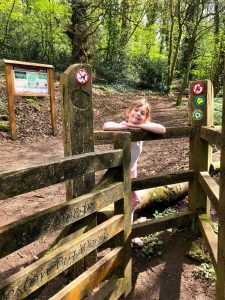
Weston Big Wood Nature Reserve is an ancient woodland between the Gordano Valley and Bristol Channel, between Clevedon and Portishead. It is a Site of Special Scientific Interest and is one of the most wildlife-rich woodlands in the area. Avon Wildlife Trust have set out a trail in the wood using lovely wooden marker posts with carvings. These tell you what wildlife you can see. In springtime bluebells grow in abundance, alongside violets and wood anemones.
Pub Stop: The Windmill in Portishead or The Black Horse in Clapton in Gordano
14. Swell Wood, Taunton
Swell Wood is a mixture of ancient woodland and an abandoned oak plantation in the Blackdown Hills, just a short drive from Taunton. It is home to the largest colony of breeding herons in the south- west. The herons nest in the tree tops of the old oak plantation. The woodland floor is awash with bluebells and dog mercury in the spring. The largest bluebell displays are along the loop of the Scarp Trail. There are three trails to explore, a bird hide and picnic benches.
Pub stop: The Crown Inn, Fivehead
15. Greyfield Wood, High Littleton
This popular woodland is great for walking, particularly during the spring to see the great bluebell display. Only 7-miles from Bath, this lovely woodland is a favourite with families due to the nearby waterfall and stream. There is a wide range of trees and wildlife, including wild deer, fox, badger, butterflies and a large bird population. You may also see evidence of its past mining activities. There is limited parking.
Pub Stop: Pony and Trap, Chew Magna
16. Ladies Walk, Montacute (NT)
You can’t go wrong with a visit to a National Trust property, and Montacute is no exception. A pleasant circular walk along the waymarked trails through the carpet of bluebells takes in lovely views over the old deer park, Montacute House and village. Ladies walk is a mature woodland full of wildflowers and birds, and carpets of bluebells in spring. Free to National Trust members.
Pub stop: The King’s Arms, Montacute
17. King’s Wood and Urchin Wood near Wrington
King’s Wood and Urchin Wood are one of the largest areas of ancient woodland remaining in the area and designated a Site of Special Scientific interest (SSSI). Although the woodlands are privately owned, there are several public footpaths running through which is perfect for spotting bluebells.
Pub Stop: The Plough, Wrington or The Crown at Churchill
18. Snakes Well Wood near Abbots Leigh
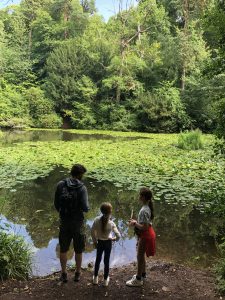
Walk through Snake’s Well Wood and visit Abbots Pool for beautiful wildflowers and scenery in the springtime. Small car park off Manor’s Lane.
Pub Stop: The George Inn, Abbots Leigh
19. Cadbury Camp and Tickenham Hill
Tickenham Hill is a nature reserve of woodland and grassland, and Cadbury Camp is the site of an Iron Age Hill Fort owned by the National Trust. The woodland is full of Bluebells and Dog’s Mercury in spring and the perfect place for a walk. There are long reaching views over the Somerset Levels to the coast. Limited parking in Tickenham (village hall or church) or Clapton Village.
Pub Stop: The Black Horse, Clapton in Gordano or, The Old Inn, Clevedon
20. Ashton Court, near Bristol
Ashton Court Estate is a country park and mansion house on the outskirts of Bristol with 850 acres of woodland and grassland to explore. You will find plenty of bluebells to admire at at Ashton Court’s Rownham Plantation and Church Wood. There is also the park’s famous red deer and gardens which are free to walk around. Paid car parks on site and courtyard cafe.
Pub Stop: The Ashton or, The Failand Inn
21. Plantation and Bluebell field near Uphill
Between Uphill and Weston Super Mare, you’ll find a 19th Century plantation of predominantly beech trees, managed by the Woodland Trust. The site is well known locally for its display of bluebells in the spring. The entrance is off Uphill Road North. There is on-road parking nearby.
Pub Stop: The Ship Inn, Uphill
22. Wayford Woods near Crewkerne
In South Somerset you’ll find Wayford Woods, near Crewkerne. It’s the perfect place to walk in spring due to the stunning bluebell display, streams throughout the woods with little bridges to walk over, a large pond and a meadow – perfect for a picnic! There is a small car park at the end of a rough track W3W: ///chairing.troubles.exploring
Pub Stop: White Lion, Broadwindsor
23. Cogley Wood, near Bruton
On the Eastern side of the Brue Valley is Cogley Wood, a Site of Special Scientific Interest and a great place for a bluebell walk in spring.
Pub stop: The Sun Inn, Bruton
24. Beacon Hill Woods, Shepton Mallet

At the Eastern end of the Mendip Hills, you’ll find Beacon Hill Woods. The lower parts of the wood are a carpet of blue in spring from the thousands of bluebells. This is a fascinating wood to visit with its stunning scenery and 10 Bronze Age burial mounds, Roman road, ponds, a large standing stone in the middle of the wood. There’s a small, free car park.
Pub Stop: The Mendip Inn
25. Hestercombe Gardens near Taunton
The Bluebell Walk at Hestercombe are stunning in spring. Take a stroll through a sensational carpet of blue around a secret wooded valley and Gotton Copse. Visit Hestercombe House and formal Edwardian garden and stop off at the traditional tearoom! There is a play area for under 7’s, book shop and seasonal events in the gardens. Admission prices here.
Pub stop: The Lethbridge Arms
26. Felton Common, near Bristol Airport
Felton Common is open access land for walkers with several designated rights of way: footpaths and bridleways. It is a Local Nature Reserve owned by Winford Parish Council. The display of thousands of bluebells in springtime across the common is stunning. The kids will love seeing the airplanes coming in to land overhead! Limited parking at the end of Felton Street (BS40 9YL).
Pub Stop: The Prince of Waterloo, Winford
27. Tarr Steps Woodland Nature Reserve, Dulverton
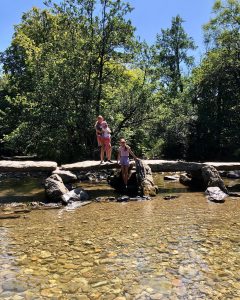
Tarr Steps is an ancient clapper bridge over the river Barle in Exmoor National Park. The surrounding woodland comes alive in springtime when extensive carpets of bluebell cover the woodland floor. Much of the Barle valley is designated a Site of Special Scientific Interest and is a stunning location for a walk alongside the river Barle. Kids will love paddling in the river! Pay and display car park and toilets.
Pub Stop: The Tarr Farm Inn (great cream teas serves too!)
28. Selworthy Beacon and Brockholes, Exmoor
A seven-mile circular walk along the South-West Coast Path near Minehead provides incredible views over the Severn Estuary to Wales. The route takes you through three pretty combes that are filled with bluebells and other wildflowers in April and May – click here for route description. Bluebells also in abundance around Selworthy Beacon, a four-mile circular walk with breathtaking views in all directions – click here for details.
Pub Stop: The Ship Inn, Porlock
29. Bathwick Wood, Bath

Bathwick Wood, just North of Bath University, is owned by The National Trust and part of the Bath Skyline Walk. Follow the trail through the woodland for a display of vibrant bluebells, wild garlic, and other wildflowers. Look out for traces of the old medieval terraces and embankments.
Pub Stop: The Bathwick Boatman
30. Castle Neroche, near Buckland St Mary
Castle Neroche is in the Blackdown Hills and a lovely place for a circular walk in the woods. Find the remains of an Iron Age Hill Fort and meander along woodland tracks to discover the bluebells and stunning views over the Blackdown Hills. Beware, there are steep steps in areas and challenging ascents and descents. Car park at TA20 3LB.
Pub Stop: Candlelight Inn, Bishopswood
31. Adcombe Wood, near Wellington
Adcombe Wood is a beautiful and mystical ancient woodland overlooking Taunton Vale in the Blackdown Hills Area of Outstanding Natural Beauty (AONB). It is designated as part of a Site of Special Scientific Interest (SSSI).
The ancient wood is steeply sloping with great displays of ancient woodland plants including bluebells.
Pub Stop: The Lamb and Flag Inn
32. Stantonbury Hill, near Stanton Prior
Stantonbury Hill is the site of an Iron Age Hill Fort (Stantonbury Camp), a scheduled ancient monument. The woodland floor on the slopes of Stantonbury Hill are covered in bluebells during April and May.
Pub Stop: The New Inn, Farmborough
How to find bluebell woods in Britain
If you don’t live in Somerset but want to find a bluebell wood near you, I suggest checking out your nearest National Trust property. Other places you can look are The Woodland Trust, Forestry Commission, your local Wildlife Trust or Nature Reserve.
Types of Bluebells in the UK
There are two types of bluebell which grow wild in the UK. The native bluebell, which is also known as the Common Bluebell, British or English Bluebell (Hyacinthoides non-scripta); and the Spanish Bluebell (Hyacinthoides hispanica). The Spanish Bluebell is an invasive species that was introduced by the Victorians as a garden plant. It is faster growing and one of the major risks to our smaller, native variety. The Spanish variety can now be found across much of the UK.
How to identify the native and non-native species of bluebell in the UK
Bluebells are one of Britain’s more easily identified wildflower but there are several differences between the native bluebell and Spanish bluebell.
Native Bluebell
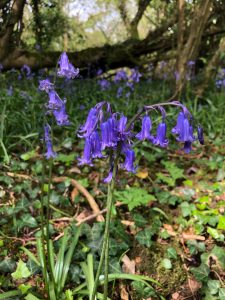
- Flower petals are a deep purple colour
- The delicate bell-shaped flowers droop to one side
- A pungent scent of perfume
- The flower petals are curved and in a tube
- The pollen has no colour
Spanish bluebell
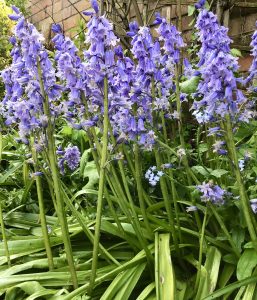
- Pale coloured petals in a light blue but can also be pink or white
- Flower petals are erect and spiked
- Pollen has a blue or green colour
- No scent
Why are Spanish Bluebells a problem?
Spanish Bluebells are invasive and faster growing than our native bluebell which means they out-compete and could wipe out the native variety in the future. The Spanish bluebell is cross breeding with our native bluebell, producing a hybrid which means the Common Bluebell could become extinct.
This would be detrimental to our British wildlife because the native English Bluebells have a slightly earlier flowering period than the Spanish variety and many other plants. Therefore, they provide a valuable early nectar source for bees, woodland butterflies, hoverflies and other pollinators.
Threats to our native bluebells
As well as the threat from the hybridisation with Spanish bluebells, there are other risks to our native bluebells. This includes habitat destruction and the illegal trade of wild collected bulbs.
Did you know? The native bluebell is protected under the Wildlife and Countryside Act (1981). This means that it is illegal to pick or dig up the plant or bulb in the countryside and landowners are prohibited from removing bluebells from their land to sell. It is an offence to trade in wild bluebell bulbs or seeds.
When you’re out walking in the woodland where bluebells are growing, keep to the paths and walk single file whenever the flowers fringe a narrow pathway.
Enjoy your walk and let us know your favourite!
Somerset Family Adventures is a free online resource. If you enjoyed this blog post and found it helpful, you can say thanks and show your support by buying me a coffee. Thanks so much! You can also sign up to our newsletter to be the first to hear of our new walks and days out.
Share this post with your friends and family, and follow us on our social media. Feel free to tag us in your photos if one of my posts has inspired you to visit.
Follow us on social media
Share this post: on Twitter on Facebook
